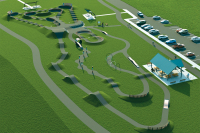Judge tells Jackson County to get moving with courthouse security
The exploration of inadequacies at the Jackson County Justice Center has been years in the making, but it’s looking like — for now, at least — the solution will focus on ramping up security and leave the issue of space for another time.
“There’s two issues I want to bring to your attention, issues I’ve been bringing to your attention for the last 10 years,” Superior Court Judge Bradley Letts told commissioners at their annual planning retreat last week.
Those issues? Security and space.
“They could be solved together, but the most pressing issue to me is the issue of security,” Letts said.
Pressing enough that he was quite clear to commissioners that moving forward is not a choice.
“We will be moving forward on this front, and I want to do it together in a constructive way, but the time has come to do that,” Letts said.
Related Items
The county has been exploring solutions to the courthouse conundrum since at least 2006, when a task force of local stakeholders issued a report. Some improvements were made in 2007, but since then reports from the U.S. Marshalls and N.C. Sheriffs Association have listed deficiencies, and last year commissioners had a $34,000 study done by Heery International, the same firm that planned the new courthouse in Haywood County. The study found that security upgrades, as well as an additional 35,800 square feet of space, were overdue.
In August 2014, Letts issued a letter giving the county a deadline of Jan. 1 to address building security, which he later extended to allow time for the Sheriffs Association report to come back.
Securing the entrance
Restricting the courthouse to a single entrance will be the first and most important step in increasing security. Right now, pretty much anyone can come in just about any door, a set-up that Letts said makes him rather uncomfortable. The only security people in the building are at the courtroom doors.
“We have about five, six entrances that people can come and go in that particular building without any obstruction or anyone checking to see what they’re there for,” said County Manager Chuck Wooten. “We all recognize that there are activities ongoing in that building that a lot of times people don’t come in with a smile on their faces.”
Commissioners took a look at some preliminary drawings from architect Odell Thompson, estimated to cost about $75,000 to construct, with the total for costs including staffing, equipment and upgrades to parking and technology to exceed $435,000.
Odell’s drawing shows a single entrance, manned by two sheriff’s deputies, at the main entrance of the courthouse side of the county administration building. Anyone coming in the building would have to pass through a metal detector and put his or her bags through a scanner. Officers would also monitor visitors as they leave the building through the same doors they entered it by.
The finished product will likely also include an expanded lobby. The addition was not part of Thompson’s original drawing or cost estimate, but Letts said he wanted to see some more space in the next go-around.
“It would basically be an atrium or holding area, because even if the weather’s good, you’re going to have a backup at high volume times,” Letts said, telling commissioners that just the other day a young woman was late to court because she couldn’t find a parking space.
Letts said he would not be comfortable with employees using a separate entrance during business hours — many non-court-related departments are housed in the same building — but that some system could be worked out so they didn’t have to get screened each time they entered the building. For example, employees could carry an ID badge with them to show officers before continuing onto their destination, and an after-hours entrance could be arranged.
“In a way, during working hours, Monday to Friday, there is a dedicated employee entrance,” Letts said. “It just happens to be co-located with the public and observed by our sheriff or security.”
Hopefully, the plans will be approved and renovations finished by July 1.
But the security upgrade will involve more than a more secure entrance. In fact, the bulk of the upgrade cost would be recurring expenses — a.k.a., salaries. Increasing security would require hiring a detention center captain, two deputy sheriffs, a detention court officer and upping the bailiff’s position, currently at 32 hours, to full time. All that would cost the county an extra $198,000 per year, plus another $79,000 to outfit the new staff with vehicles and personal equipment.
“Our current security starts and consists only of the courtrooms themselves,” Sheriff Chip Hall explained. “We do not do the entire facility.”
That was one of the biggest security shortcomings addressed in a December report the N.C. Sheriff’s Association issued to the Jackson Sheriff’s Office. But it was far from the only one. The report listed 30 areas in which security in the building was lacking, spanning everything from parking to communications to courtrooms.
After the report was issued, the Sheriff’s Department formed the Courthouse Security Committee, a group of 18 legal and law enforcement leaders in Jackson County tasked with meeting quarterly to develop needed policies and procedures for the courthouse and to generally identify and advocate for any security changes needed.
“We’re one of only approximately 15 counties in the whole state that have no security in the courthouse,” said Letts, who has held court in more than 20 of the state’s 100 counties.
The security upgrade will also likely include some ramped-up surveillance equipment. The stuff that’s there now is old, and it also isn’t comprehensive. It doesn’t cover all of the grounds and parking lot, and there aren’t any cameras in the building. There also isn’t a dedicated space for security personnel to observe the footage.
The tentative plan includes $20,000 for camera equipment and another $15,000 for video arraignment equipment, which would allow a judge to issue standard rulings such as setting bail via video monitor, saving staff from transferring inmates from their cell to the courtroom for their five minutes with the judge.
“One thing that we are discussing — with cameras also comes the need to have a monitoring location,” Wooten said.
The 911 call center will soon be relocated as a new hub is built, hopefully by mid-March, so Wooten said the camera equipment could occupy one of those rooms.
Though for now the discussion centers only around the immediate need for more security at the courthouse, Wooten told Letts that the county is still very much aware of the need for more space.
“We do appreciate there’s not enough space there to do what needs to be done. Part of our security issues there are related to space,” Wooten said. However, in the immediate future, “We’ll be challenged to be able to do very much with the building.”
Change in the works
In December, the N.C. Sheriff’s Association released a report detailing a list of 30 areas in which the Jackson courthouse falls short on security. The county’s planned fixes — subject to final design plans and a vote — include:
• Restricting the building to a single point of entry. During business hours, anyone coming into the building will have to enter and exit through the same door, and security personnel will be on hand to screen bags and monitor the doors. County employees working in the building — save those in the sheriff’s department, who will have a separate entrance, will also have to pass through that door but would likely be given a badge to flash to security, exempting them from screening.
• Installing new security cameras and designating a person to monitor them and a space in which to do so.
• Designating parking for judges and jurors, and moving judge parking to a more protected area than its current site at the front of the building.
• Protecting the building from being run into with a vehicle, using tools such as barriers, bollards or walls.
• Conducting safety drills for events such as fires, medical emergencies or active shooters.
• Limiting access to judges’ chambers through minor hallway renovations. Renovations would also be needed to better segregate inmates from the general public.









